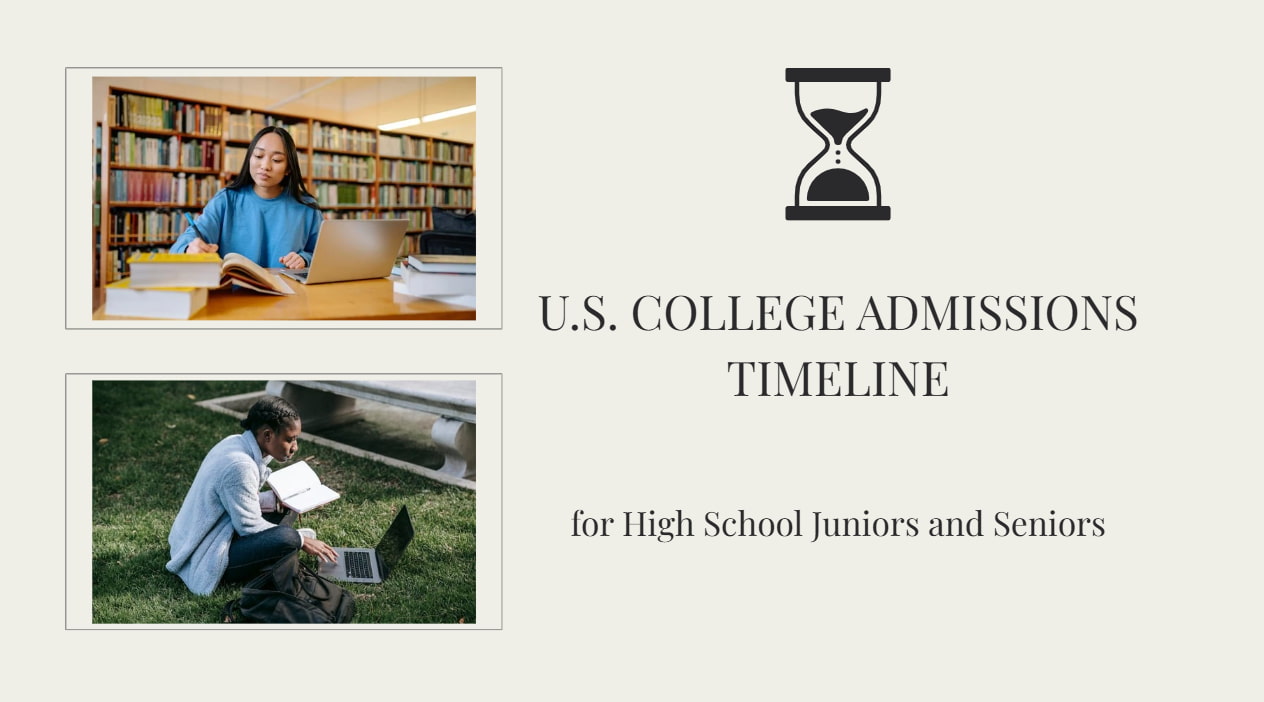Many students feel stressed as soon as they hear about the college admissions timeline. As a college admissions consultant, I’ve seen this happen a lot of times. But this process is much easier to handle when you have a clear plan, and if you know about the US college admissions timeline early on, you can get an edge over other candidates.
The US College Admissions Timeline — An Overview
The US college admissions deadline is an organized process that typically takes two full years. It starts in your junior year when you start building your academic and extracurricular profile and goes on until you accept a college offer in your senior year.
Colleges also set various application options, each with its deadlines and expectations. Early Action, Early Decision, and Regular Decision deadlines are the three most common.
While Early Action deadlines typically fall around November 1, Early Decision deadlines may be the same or slightly earlier. Regular Decision applications are often due in January or early February.
| Application Type | Deadline Range | What It Means |
|---|---|---|
| Early Action | November 1 – November 15 | Non-binding; allows early review and decision. |
| Early Decision I | November 1 – November 15 | Binding; you must attend if accepted. |
| Early Decision II | January 1 – January 15 | Binding; second early round for students needing more time. |
| Regular Decision | January 1 – February 1 | Standard deadline; most students apply during this round. |
| Rolling Admissions | Varies by school | Applications reviewed as they are submitted. |
Note that deadlines vary from school to school, so it’s better to contact the admissions office directly for clarification.
Some colleges have two Early Decision deadlines to give students a bit more flexibility while still letting them show that a school is their top choice.
Another important part of the process is the Common Application, which more than 1,000 colleges accept. The Common App for each admissions cycle typically opens on August 1, but you can create an account earlier and start drafting your personal statement.
You can plan everything from studying for tests to preparing essays without worry at the last minute if you know this college admissions timeline. And if you decide to apply to college, early preparation also increases your chances of receiving financial aid, scholarships, and merit-based rewards.
Early Action and Early Decision Admission Timelines
These routes give applicants the opportunity to choose to apply early, which can increase the chances of standing out before the class is filled. Early plans are ideal for students who are confident about their first-choice institutions.
Early action is a non-binding option, meaning you can still apply to other colleges. In contrast, early decision is binding, which means you must attend the school if you are accepted and will need to withdraw all other applications.
Most early decision and early action deadlines fall in early November, but exact regular application deadlines and application early dates can vary from school to school.
Here’s how students should approach these timelines:
- Open their applications as early as possible, usually in August, to get familiar with requirements.
- Start working on their applications over the summer, including essays and recommendation letters.
- Submit the regular application or early forms before the priority deadline to maximize admission chances.
- Coordinate with the admissions office directly to confirm requirements if you are unsure.
- Track the entire admissions cycle to ensure you’re ready to begin college the following fall.
The admissions committee and the admissions office directly look for well-prepared applicants who meet all deadlines.
If you miss the priority deadline, you risk falling behind other applicants, especially at schools with rolling admissions where the application cycle fills up quickly.
College Admissions Timeline for High School Juniors
Your junior year is the foundation of your entire plan to apply for college. Your grades, extracurricular activities, and personal hobbies will start to shape the story that admissions officers will read when they review applications.
From what I’ve seen, students who spend this year productively get more college options, better scholarship chances, and a smoother path to a successful college experience.
🍂 Fall of Junior Year
I always tell my students that junior year grades carry the most weight in the college admissions process timeline.
Colleges want to see that you can handle challenging coursework, so consider taking AP, IB, or honors classes if they match your strengths. A strong GPA combined with a rigorous schedule sends a clear message that you’re ready to begin college and succeed at a higher academic level.
This is also the perfect time to get involved in extracurricular activities. Join clubs, sports teams, or volunteer programs that genuinely interest you. Admissions officers can easily tell when a student is simply adding activities versus when they’re truly passionate. If possible, take on leadership roles or start initiatives that show your ability to contribute and inspire others.
Another important step is building relationships with your teachers. I often remind students that recommendation letters play a huge role when schools open their applications and evaluate candidates.
❄️ Winter of Junior Year
Winter is the season to get serious about standardized tests like the SAT or ACT. Take a diagnostic test or a full-length practice test to gauge your starting point. Once you know your strengths and weaknesses, create a study schedule or consider a prep course. Even improving your score by a few points can make a big difference when applying to competitive schools.
At the same time, start preparing your application by building your college list. Research colleges based on academic programs, campus culture, and location. I usually suggest students create three lists:
- Reach schools
- Match schools
- Safety schools
This approach helps you map out your college application timeline and plan for every step of the process.
🌸 Spring of Junior Year
Spring is a great time to visit colleges—either in person or virtually. Attending open houses, information sessions, or just walking around a campus can give you a real sense of its atmosphere. Meanwhile, keep pushing forward in extracurriculars.
The spring semester is the ideal time to showcase your leadership skills by taking charge of projects or school events. These experiences make your application stand out when the admissions committee begins its review.
☀️ Summer Before Senior Year
Summer is your golden opportunity to get a head start on senior year and start preparing your application for the upcoming cycle:
- Draft your personal statement and brainstorm ideas for supplemental essays. Writing early gives you plenty of time to polish your work without pressure.
- Consider applying for internships, research programs, or part-time jobs.
- If possible, visit colleges again during the summer to attend workshops or orientation programs for prospective students.
- Lastly, review your senior year schedule. Make sure you’re signed up for challenging courses that reflect your interests and strengths.
These efforts tell colleges that you remain committed to academic success and are ready to begin college with confidence.

General College Admissions Timeline for High School Seniors
It’s really important to prepare ahead since senior year goes by so quickly. I think that this year, being organized and managing your time well will make all the difference in following the right college application timeline.
🍁 Fall of Senior Year – Applications Kick Off
From August to November, your main focus should be on finalizing your college list, polishing your personal statement, and requesting recommendation letters.
Most early application deadlines, like when you apply early action or Early Decision, fall in November, so you’ll need your essays and test scores ready well before college applications due dates.
To stay on track during this busy season, I suggest you follow a simple checklist:
- Finalize your list of colleges and their deadlines, which vary from school to school.
- Complete or revise your personal statement and supplemental essays.
- Ask teachers or mentors for recommendation letters early.
- Register for any last SAT/ACT test dates if needed.
- Research scholarships and financial aid opportunities, including the Free Application for Federal Student Aid (FAFSA).
- Begin filling out the Common App or other college portals during the application window.
This is also the time to start narrowing your college list to a mix of reach, match, and safety schools. Submitting early can show the admissions committee that you’re a serious applicant.
❄️ Winter of Senior Year – Submitting Applications
January and February are when most Regular Decision college applications are due. This is the perfect time to submit transcripts, send in test scores, and finalize your FAFSA, which opens on October 1.
In my opinion, winter is an ideal time for local or national scholarship applications to reduce your college expenses.
🌼 Spring of Senior Year – Admission Decisions
March and April bring the moment you’ve been waiting for: acceptance letters and admission decisions. This is an exciting yet overwhelming phase, especially when you have multiple offers to consider.
I always recommend visiting your top choices again if possible—attending admitted student events can help you feel which school is the best fit. When comparing schools, don’t just look at rankings or prestige. Consider financial aid packages, campus culture, academic programs, and student support services.
Remember that you must commit by May 1, which is the national decision deadline.
☀️ Summer Before College – Final Steps
Once you’ve committed to a school, send your final transcript, set up housing, and complete any forms the college requires for orientation.
Summer is also the perfect time to get familiar with your new campus, connect with future classmates, and prepare for any summer assignments or placement tests.
I always tell my students to make the most of this time—learn how to handle their time well, review important school subjects, and get ready for the smooth start of the following fall semester.
Final Thoughts on Common College Application Deadlines
Honestly, I think the secret to a smooth college admissions timeline is pacing yourself and focusing on the right priorities at the right time:
- Junior year is all about building a strong academic record and getting involved in activities that actually mean something to you.
- Senior year? That’s when it’s all about locking in your applications, writing great essays, and making smart final choices.
If you’re feeling unsure about how to manage everything, check out BestCollegeAdmissionConsultants.com. They have expert tips and guidance that can help you make a strong plan and keep track of deadlines for your college application process.

